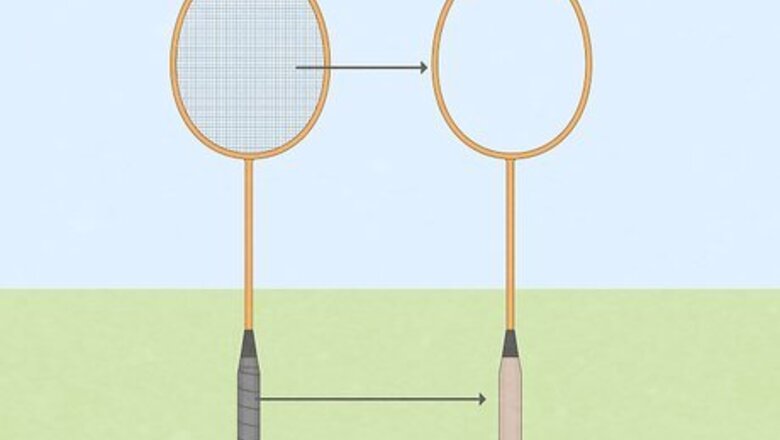
views
- Hold the racket parallel to the ground, then place your pointer finger under the shaft, near the midpoint.
- Adjust the shaft of the racket back and forth until the racket balances on your finger without your aid. Where your finger rests is the balance point.
- A head-heavy racket’s balance point is closer to the head, and a head-light racket’s is closer to the grip. The balance point is in the center on an even-balanced racket.
Finding the Balance Point
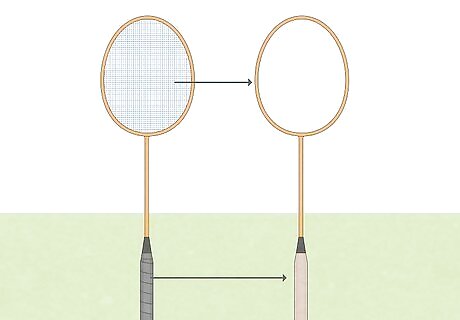
Remove the strings and grip tape from the racket (optional). Visit a pro shop to have the strings removed properly. You won’t find a racket’s “true” balance point unless it’s free of strings and gripe tape, both of which influence the weight at both ends of the racket. Most pro shops advertise the unstrung, ungripped balance point of their rackets on the label. Note that most beginner players buy prestrung and pre-gripped rackets, so don’t worry too much about removing these if you don’t plan to make any major tweaks to the racket itself. Weighted grip tape and heavier strings are often used to intentionally rebalance a racket. Ask a pro shop employee to outfit your racket appropriately if you’re looking to specifically alter its balance.
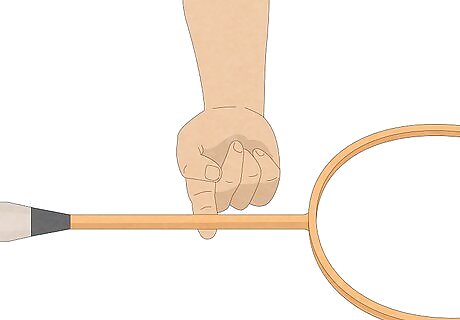
Balance the shaft of the racket on your index finger. Hold the head or the grip of the racket in one hand, then place the index finger of your other hand beneath the shaft, toward the middle. Make sure the strings of the racket run parallel to the ground. Do this over a table or a soft surface to protect your racket in case you accidentally drop it. Alternatively, use a smooth, thin tube like a pen or a pencil to more accurately gauge the balance.
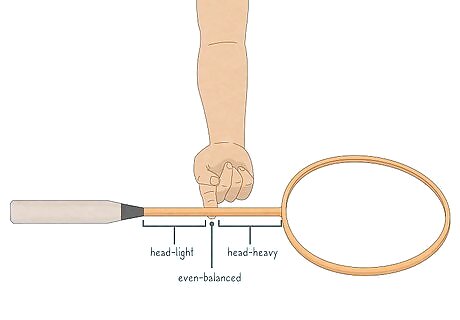
Shift the placement of your finger along the shaft to find the balance point. Slide the racket’s shaft along your finger, adjusting it as needed until the racket can balance without you supporting it. Mark this position with a bit of painter’s tape—this is the balance point. Depending on where this spot is on the shaft, your racket is 1 of the following: Your racket is “head-heavy” if the balance point is closer to the head than the grip. The midpoint of these rackets is often more than 300 mm (12 in) from the grip. Your racket is “head-light” if the balance point is closer to the grip than the head. The midpoint of these rackets is often less than 280 mm (11 in) from the grip. Your racket is “even-balanced” if the balance point is an equal distance from both the head and the grip (use a tape measure to be sure). The balance point of these rackets is often about 280–300 mm (11–12 in) from the grip.
Choosing a Racket Based on Balance

Choose an even-balanced racket if you’re a beginner. These are also called “primary rackets,” and are great all-around rackets, providing both power (how hard you propel the shuttlecock) and stability (how accurately you can hit the shuttlecock). They’re ideal for players who want to learn to play badminton, and who don’t want to worry about the nitty-gritty of choosing a racket just yet. In addition, even-balanced rackets are preferred by versatile players who find themselves diving for the shuttlecock, slamming it over the net, and hitting accurate or more technical shots with equal frequency. The Yonex ArcSaber 7 is a great, even-balanced racket for beginner players looking to jump into the game.
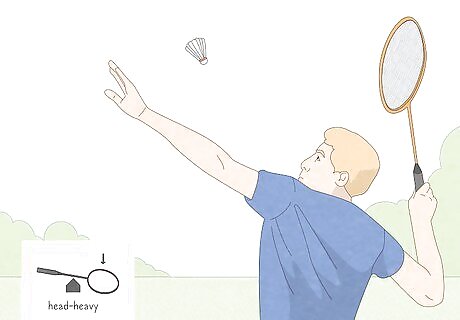
Go for a head-heavy racket to hit more powerful shots. A heavier head provides more force at the point at which the racket makes contact with the shuttlecock. More force makes for a harder and faster hit. Choose a head-heavy racket if you want to smash the shuttlecock and put offensive pressure on your opponent. They’re also great for players who like to make long-distance shots from the back of the court. Note that a head-heavy racket can be a bit more unwieldy for inexperienced players, since all the weight is focused on the end of the racket, making it more difficult to swing quickly and accurately. Pick up an Astrox 77 Play] for a great introductory head-heavy racket.

Choose a head-light racket for more control and accuracy. A head-light racket focuses the bulk of its weight in the grip of the racket, making it more comfortable to hold and easier to maneuver. This makes it ideal for fast-paced rallies and precise shots, making for a more consistent ability to return your opponent’s shots. But since the head is relatively light, these rackets tend to have less power, making for typically slower and shorter-range hits. Pick up a head-light racket if you enjoy playing closer to the net, since these rackets allow you to more quickly respond to your opponent’s plays. Go for a Victor Jetspeed for a lightweight and trusty head-light racket.
Other Considerations
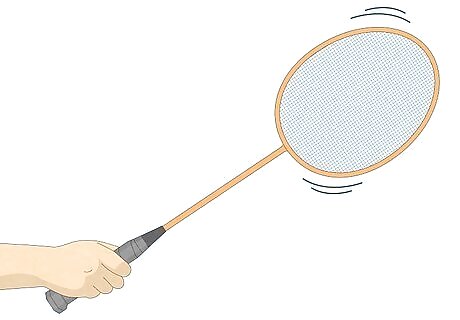
Find a racket that’s not too heavy in the hand for comfortable play. We’re not talking balance here, but overall weight. If you’re testing rackets in a shop, give them a quick overhead swing. Did it feel easy? Or did it take a bit of wind-up to execute? Or, did it feel like you were holding nothing at all? Ideally, you can swing your racket without much effort or thought, while still being intuitively aware of the position of the head. If you’re a beginner, find one that’s about 75–85 grams (0.165–0.187 lb), which tends to be a good sweet spot for most novice players. Rackets are often classified by weight using the “U” system. Rackets that weigh 75–79 grams (0.165–0.174 lb) are “5U,” and those that are 80–84 grams (0.176–0.185 lb) are “4U.”
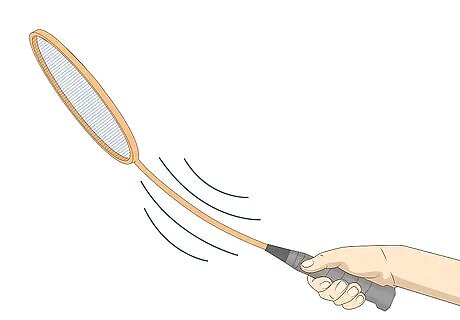
Go for a racket that’s described as “flexible” if you’re a beginner. Check the packaging or the label on the racket. Those with the word “flex” tend to have more bend to the racket, which lets beginners more easily add power to their shots, since the racket bends backward slightly as you swing, and quickly comes forward as you make contact with the shuttlecock. Flex rackets do tend to have less control than stiffer rackets, but their added power is a worthy tradeoff for novices who are getting their bearings. Pick up a racket labeled as “stiff” if you want to have greater accuracy and make more consistent shots, since you have more control over the movement of the racket.
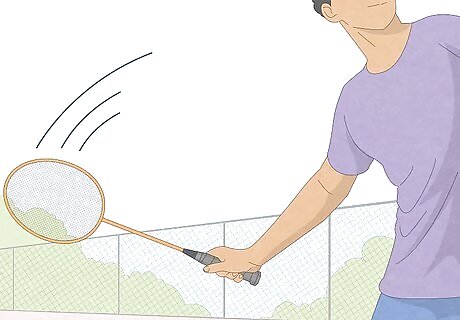
Test different rackets and pick the one that feels best to swing. Badminton rackets come in all sorts of variations, with minute differences between each kind. Things like the string tension or grip size may not be advertised, but still affect how you play, whether you notice it or not. The best way to choose a racket is to try several, and pick the one that feels the best in your hand and which lets you make the most confident shots the most consistently. That’s the racket that will help you play a better game of badminton. Some trusted and quality badminton racket manufacturers include Yonex, Li-Ning, Ashaway, Babolat, Adidas, and Victor. Look for these brands in stores or online.
















Comments
0 comment